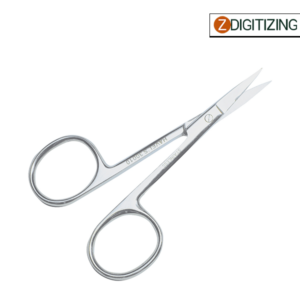In this article we will explore 5 best embroidery scissors you need to know while using an embroidery machine.

When it comes to embroidery machine, having the right tools is essential to achieve precise and professional results. One of the must-have tools for machine embroidery is a good pair of embroidery scissors. These specialized types of scissors in embroidery machines are designed to make precise cuts on thread and fabric without damaging the surrounding stitches or materials. If you’re looking to invest in quality machine embroidery scissors, here are five top options worth considering:
5 Best Machine embroidery scissors you need to know
5 Best Embroidery Scissors You Need To Know
Let’s see some of the best types of scissors you need to know like embroidery applique scissor, embroidery design cutwork, embroidery room scissor need, etc.
Gingher 4-Inch Embroidery Scissors:

Gingher is a renowned types of scissors brand known for producing high-quality Embroidery room scissor need, and their 4-inch embroidery scissors are no exception. With their sharp and fine blades, these scissors offer excellent control and precision for trimming thread and fabric in machine embroidery projects like embroidery design cutwork, etc.
Kai 5130 Thread Snips:
Kai is another trusted brand in the world of embroidery scissors, and their 5130 Thread Snips are a popular choice among machine embroiderers. These snips feature sharp and pointed blades that allow for clean and accurate thread trimming. They are also lightweight and comfortable to hold, making them ideal for extended embroidery sessions.

Embroidery Digitizing
&
Vector Art Services
Are you looking for embroidery digitizing and vector art services at low cost with superfast turnaround, guaranteed quality and preview before pay? So, you are at right place. We can digitize and vectorize any type of artwork in your required file format.
Dovo Stork Embroidery Scissors:

If you’re looking for scissors that combine functionality with an elegant design, the Dovo Stork Embroidery applique Scissors are a great option. These scissors feature a stork-shaped handle, which adds a touch of charm to your embroidery toolkit. The sharp blades and fine points ensure precise cuts, while the overall design provides a comfortable grip.
Havel's Ultra Pro Embroidery Scissors:
Havel’s Ultra Pro Embroidery Scissors are designed specifically for machine embroidery enthusiasts. These scissors have micro-serrated blades that provide extra grip and prevent slipping, allowing for precise cutting of various types of threads. The ergonomic handle design makes sure that you are comfortable and controlable during use.

Klasse Embroidery Scissors:

Klasse Embroidery Scissors are known for their durability and sharpness, making them a reliable choice for machine embroiderers. The stainless steel blades are designed for precision cutting, and the lightweight design allows for effortless maneuvering around delicate embroidery stitches. When selecting machine embroidery scissors, consider factors such as blade sharpness, size, handle comfort, and overall durability.
It’s important to choose a pair that suits your specific embroidery needs and feels comfortable in your hand. With the right machine embroidery scissors, you can achieve clean and precise cuts, enhancing the quality and appearance of your embroidery projects.
Tips For Using Scissors In Embroidery:
Here are some tips for using scissors in embroidery:
- Select scissors specifically designed for embroidery. Look for sharp, pointed blades with a fine tip that allows for precise cutting. Consider the size and weight of the scissors to ensure they are comfortable to handle.
- Regularly sharpen your embroidery scissors to maintain their cutting efficiency. Utilize a sharpening stone or take them to an expert sharpening service. Sharp scissors make sure clean cuts and prevent fabric fraying.
- Consider having multiple pairs of embroidery scissors for different purposes. For example, use small, sharp-pointed scissors for detailed work, curved scissors for cutting close to the fabric, and applique scissors for trimming fabric around applique shapes.
- Handle your embroidery scissors with care to prolong their lifespan. Avoid dropping them or using them on hard surfaces that could dull or damage the blades. Store them in a protective case or sheath to prevent accidental damage.
- When cutting threads or fabric, position the scissor blades close to the material to achieve clean cuts. Take your time and make small, precise cuts rather than trying to rush through the process. Practice cutting on scrap fabric to improve your technique.
- Remove any lint or debris from the scissor blades after each use. Apply a drop of sewing machine oil or lubricant to the pivot point to ensure smooth movement. This helps maintain the scissors’ performance and prevents rusting.
- Avoid using embroidery scissors for tasks other than embroidery. Using them for paper, cardboard, or other materials can damage the blades and affect their cutting ability.
- Hold the scissors in a comfortable and natural grip. Position your hand close to the material you’re cutting to have better control and precision.
- For cleaner cuts, try to cut in one continuous motion rather than repeatedly opening and closing the scissors. This helps prevent fabric fraying and ensures a smoother finish.
- Before cutting your embroidery work or main fabric, practice on a scrap piece to ensure you’re using the right amount of pressure and achieving the desired result. This helps avoid any accidental mistakes on your actual project.
- When cutting fabric for embroidery, pay attention to the grain or direction of the fabric. Make sure the scissors are cutting perpendicular to the grain to prevent distortion or stretching of the fabric.
- If you experience discomfort or strain while using scissors, consider using scissor grips or thimbles. These ergonomic tools provide additional support and help reduce hand fatigue during extended embroidery sessions.
- Embroidery can be time-consuming, so remember to take breaks to rest your hand and fingers. Continuous cutting can strain your muscles, so giving yourself short breaks can help prevent fatigue and improve accuracy.
- To maintain the sharpness and precision of your embroidery scissors, avoid using them for other tasks, such as cutting paper or fabric with adhesive. This helps prevent dulling the blades and keeps them in optimal condition for embroidery.
- When not in use, store your embroidery scissors in a safe and dry place. Consider using a scissor case or pouch to protect them from dust and accidental damage. Avoid tossing them into a cluttered drawer where they can get tangled or scratched.
Remember, using high-quality embroidery scissors and practicing proper scissor care will enhance your embroidery experience and result in clean, precise cuts for your projects.
Frequently Asked Questions
Embroidery scissors are essential tools used in embroidery to precisely cut thread and trim excess fabric. Their small and pointed blades allow for intricate and delicate work.
Embroidery scissors differ from regular scissors in their design and functionality. They usually have sharp, fine-pointed blades that enable precise and controlled cutting in tight spaces.
Embroidery scissors are primarily used for cutting thread and trimming fabric in embroidery projects. Their small size and sharp blades make them ideal for intricate stitches and precise cuts.
To keep embroidery scissors sharp, avoid using them for tasks other than embroidery, such as cutting paper or fabric. Regularly wipe the blades clean after use, and consider using a sharpening tool or professional service to maintain their sharpness.
Embroidery scissors are often shaped like storks as a traditional design choice. The stork-shaped handles add a decorative element to the scissors, making them visually appealing for embroidery enthusiasts. Additionally, the curved beak of the stork shape allows for better control and maneuverability when making intricate cuts.












